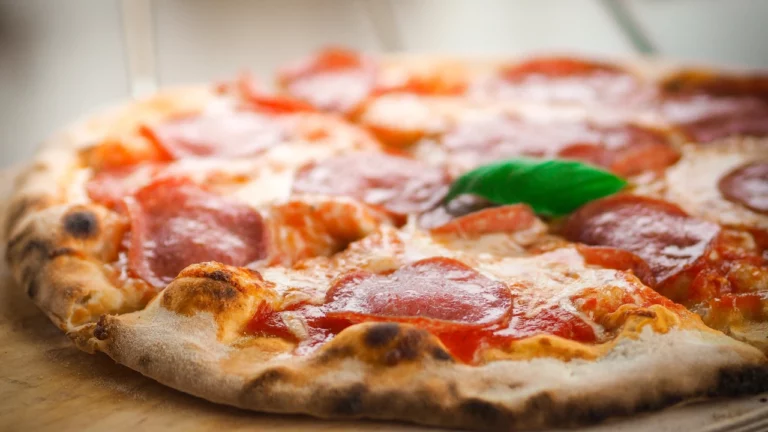Pizza has become a global favourite comfort meal due to its delicious blend of cheesy richness, savoury toppings, and crunchy crust. While enjoying a piece now and again is a normal pleasure, consuming it frequently raises concerns about its potential health effects. In this investigation, we examine the issue, “Is pizza unhealthy?” and examine the effects of eating pizza on your body on a weekly basis.
The Pizza Paradox:
Ingredients: Although there are many variations of this adaptable cuisine, the essential ingredients are usually as follows:
Dough: Usually formed from refined wheat flour, dough is the base of the crust.
Cheese: A significant calorie and saturated fat source.
Tomato sauce: May have additional carbohydrates, but it also contains lycopene, a potent antioxidant.
Meat and toppings: Various and can include everything from processed meats to veggies, which might affect the nutritional value.
Oils and seasonings: Added flavour during preparation, but also increase calorie count.
The Contaminant Image: Pizza’s high calorie and saturated fat levels have contributed to its image as a potentially harmful eating option. Making educated food choices requires knowing the effects of ingesting it on a daily basis.
HEALTH TIP
To make sure you get a wide range of vital vitamins and minerals, include a variety of nutrient-dense foods in your diet.
Read Also: Importance of Quality healthcare and education
What Takes Place in Your Body Upon Weekly Pizza Consumption:
1. Obesity Risk and Weight Gain:
Density of Calories: Pizza typically contains a high content of refined carbs, fats, and proteins, making it high in calories. Overindulging in calories on a regular basis can result in unhealthy weight gain , and pizza ‘s high caloric density can contribute to obesity when taken in excess.
Saturated Fats: High in saturated fats include cheese and processed meats, which are frequently used as pizza toppings. Saturated fat-rich diets are linked to a higher risk of obesity and related health problems.
2. Effect on Heart Health:
Salt Content: Pizza, particularly its processed meats and cheese, can be a major source of salt and unhealthy. Elevated blood pressure and a higher risk of cardiovascular illnesses are associated with high salt consumption.
Saturated Fats and Cholesterol: Over time, the accumulation of plaque in arteries can be facilitated by the combination of saturated fats and cholesterol found in pizza components. This could result in heart-related complications.
3. Refined Carbohydrates and Blood Sugar Fluctuations:
The refined wheat flour used in pizza dough can cause sharp rises in blood sugar levels. Regular intake of refined carbohydrates may raise the risk of type 2 diabetes and insulin resistance.
Added Sugars: A portion of pizza sauces could include added sugars, which may be unhealthy or raises the meal’s total sugar level. Metabolic disruptions and insulin resistance are linked to excessive sugar consumption.
4. Digestive Problems: Insufficient Fibre:
Pizza often has a low fibre level, which is detrimental to digestive health. Constipation and other digestive problems can be worse by a diet low in fibre.
Processed Ingredients: The intestinal health of certain people may be affected by the processed meats and other additives included in pizza. Excessive processing of food items can change the gut microbiota’s makeup, which may have an impact on digestion and general health.
5. Nutrient Deficit: Restricted Range of Nutrients:
Although the components in pizza give certain necessary nutrients, eating pizza all the time might result in a diet lacking in diversity. Over time, deficiencies may arise from a diet deficient in a variety of nutrients.
Low in Micronutrients: A diet high in pizza may be deficient in some vital vitamins and minerals, which might have an effect on immune system and general health.
Healthier Alternatives for Pizza
There are a few inventive solutions that will satiate your appetites for pizza while serving as a nutrient-dense meal if you’re searching for healthier substitutes for classic pizza. These delectable alternatives can help address concerns about whether pizza is unhealthy:
Pizza with Cauliflower Crust:
Cheese, egg, cauliflower, and spices are the ingredients.
Why it’s a worthwhile substitute: A gluten-free, low-carb alternative with a texture akin to regular pizza dough is cauliflower crust. It’s a fantastic method to consume more vegetables while consuming less carbohydrates.
Complete Grain or Whole Wheat Crust:
Ingredients: Salt, water, yeast, and whole wheat or whole grain flour.
Why it’s a worthwhile substitute: When it comes to fibre and nutrition, whole grain crusts are superior than those made with refined flour. They support improved digestion and long-term energy.
Pizza with zucchini or aubergine:
Ingredients: cheese, toppings, tomato sauce and sliced aubergine or zucchini.
Why it’s a worthwhile substitute: Your pizza will include more vegetables if the foundation is made of zucchini or eggplant. Just grill or broil the pieces, then top them with your preferred pizza toppings.
Pizza with Portobello mushrooms:
Cheese, garnishes, tomato sauce, and portobello mushroom caps are the ingredients.
Why it’s a worthwhile substitute: The earthy flavour and meaty texture of portobello mushrooms are appealing. They may provide a healthy, gluten-free base for your pizza and are low in calories.
Read Also: 3 Best Breakfast Cereals/Mueslis In India
Pizza with a sweet potato crust:
Ingredients: Egg, spices, almond flour, and sweet potatoes.
Why it’s a worthwhile substitute: Sweet potatoes are high in vitamins and minerals and lend a naturally sweet flavour. This crust gives your pizza a distinctive twist and is free of gluten.
Pizza with Quinoa Crust:
Quinoa, water, egg, and spices are the ingredients.
Why it’s a worthwhile substitute: As a complete protein, quinoa provides a wholesome crust for your pizza. The crust has a light nutty flavour and is free of gluten.
Bites of Cauliflower Pizza:
Cheese, egg, cauliflower, and garnishes are the ingredients.
Why it’s a worthwhile substitute: Cauliflower pizza bits offer a quick and bite-sized alternative. They may be personalised with different toppings and are excellent for portion management.
PRO TIP
Read labels to learn about the nutritional value and quality of the ingredients while making or ordering pizza. Select sauces with less added sugar, avoid processed meats, and use whole-grain crusts.
Pita bread or flatbread:
Ingredients: Cheese, tomato sauce, whole wheat pita or whole grain flatbread, plus toppings.
Why it’s a worthwhile substitute: Making a healthy pizza is simple and quick when you use pita or whole grain flatbread as the basis. It provides the comforts of pizza with extra nutritious value.
Pizza with Greek Salad:
Ingredients: Feta cheese, cherry tomatoes, cucumbers, olives, and a drizzle of olive oil over a bed of mixed greens.
Why it’s a worthwhile substitute: This pizza substitute eliminates the typical crust completely, offering a crisp and light alternatives. It’s a fantastic option for anyone trying to cut back on their carb intake.
Pizza al caprese zoodle (zucchini noodles):
Ingredients include fresh tomatoes, mozzarella cheese, balsamic glaze, basil and zucchini noodles.
Why it’s a worthwhile substitute: In this low-carb version, zucchini noodles are used in place of the typical pizza crust. With the traditional Caprese combo, it’s a tasty and lighter option.
In Conclusion:
Although many men, women & LGBTQ+ love the odd slice of pizza, making it a weekly meal demands careful evaluation of its possible health effects. Finding a balance between enjoying the delectable taste of pizza and upholding a health-conscious lifestyle may be achieved by being aware of ingredient selections, quantity calculations, and general dietary patterns. Like with any dietary choice, seeking the advice of medical specialists or nutritionists can yield tailored recommendations depending on a person’s circumstances and health objectives.
Read Also: Hip Enlargement-Most Common Misconceptions
Key Takeaways
- Pizza consumption must be moderated in order to prevent the possible health hazards brought on by a diet high in calories and saturated fat.
- To lower the total calorie and saturated fat intake, choose healthier pizza toppings like veggies, lean meats, and less processed options.
- To prevent consuming too many calories, pay attention to portion sizes. Portion control can be achieved by splitting a pizza or reserving leftovers for another meal.
Frequently Asked Questions
1. Is pizza bad for Men, Women & LGBTQ+
In moderation, pizza may be a component of a balanced diet. On the other hand, consuming pizza with toppings high in calories and saturated fat on a daily basis may cause health problems.
2. I’m attempting to lose weight; is it okay to eat pizza?
Yes, you can still enjoy pizza while attempting to reduce your weight, but in order to control your calorie consumption, you must pay attention to portion sizes and select healthy toppings.
3. Are pizzas made without meat healthier?
Pizzas made entirely of veggies as opposed to those with high-fat meat toppings may be healthier when made using a variety of vegetables. Portion sizes and ingredient selections are still quite important, though.
4. What is a healthy way to bake pizza at home?
When creating pizza at home, use whole grain or cauliflower crust, use lean meats and lots of veggies, select lower-fat cheese, and watch portion sizes.
5. Can a diet that is balanced include pizza?
Yes, when eaten in moderation along with a range of nutrient-dense foods, pizza may be a component of a balanced diet. It’s important to choose your toppings and portion quantities carefully.



